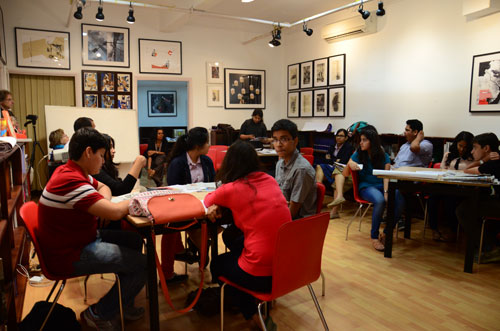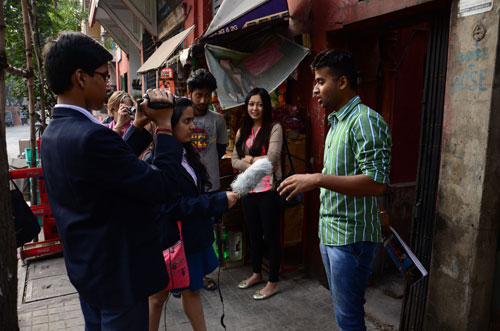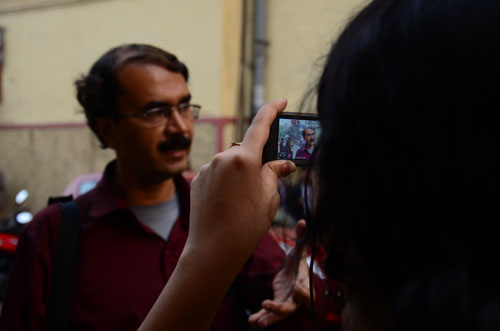‘I love Bollywood dance moves and I want each one of you to introduce yourself with one move’ was how Aaron Peterer from the Anne Frank House, Amsterdam began the three-day Free2Choose Create workshop. At the end of the introduction, the fourteen of us had outdone Farah Khan in creating the next magnum opus for Hrithik Roshan or even King Khan. The step back into the less glamorous world of the workshop was a stupendous dive into harsh realities of the Holocaust beginning with The Short Life of Anne Frank. After the movie, the group delved into an in-depth discussion on how Hitler rose into power. ‘With all his promises and propaganda’ ‘Why the Jews?’ ‘Why did the people follow him when he dehumanized humans?’
With the fundamental question of how one human can treat six million others with such brutality, the discussion moved on to the Universal Declaration of Human Rights. We were divided into groups, each one to research and answer one of the following questions:
- Why is it important to deal with the UDHR?
- What is the content and set up of the UDHR?
- When and by whom was it introduced?
- What is the judicial significance of the UDHR?
- How did the rest of the world introduce the UDHR in its international contracts?
Having deciphered extremely precise answers—thank you Google—we were given handouts of the abridged, simplified version of the UDHR. After a cursory reading, we saw two Free2Choose films that had been made in previous workshops. Two topics, one on the case of Edward Snowden—the dilemma between right to privacy and the right to security and one on overt display of religious symbols in educational institutions—the predicament where the right to express one’s identity contradicts the right to equality, were argued upon with great heat and intensity for neither side of the argument, in technicality, was a violation of human rights. This was how one of the arguments proceeded:
‘There should be no reference to religious symbols in schools . . .’
‘The school as an entity is perfectly under its right to express its sentiments’
‘However, when so many impressionable minds gather, it is better not to distinguish them based on religion.’
‘Isn’t it better that the “impressionable minds” are taught in schools about learning to live with differences?’
‘A school is a temple of knowledge, of education. The focus should be on impartial teaching and learning.’
‘The very fact that you call a school a temple is making it religious . . .’
Noise of everyone talking at the same time
‘Guys, guys, quiet. This discussion can go on forever. But this is what I mean when I talk about a dilemma within human rights’ —Aaron attempting to close the discussions and arguments.
After lunch, as we were settling down for a drowsy post-lunch-on-a-Sunday session, Aaron excused himself for having had to take an important call. It so happened that the call was from Ban Ki-moon who had just heard of four new islands that had been found near the Andaman seas. As luck would have it, Aaron informed Ban Ki-moon he was in a workshop dedicated to human rights and would help Mr Ki-moon create identities for each of the countries along with a set of four human rights.
Who could refuse the wishes of the UN general Secretary?
Instantaneously dividing ourselves into four groups we, the governing and judicial authority of each of the new found islands designed a flag, named our country and chose four of the thirty human rights based on which our entire constitution would rest. We went further ahead in choosing our national anthems and couldn’t help but perform little moves with it; remember our stalwart choreography? After justifying why we chose the said rights, there was a moment of futility to prioritize the articles of the UDHR. However, epiphany struck fairly soon that each right is important in its own way, despite contradicting one another at times.
The last activity for the day involved going through different daily newspapers to pick out cases of human rights violation; the question being were these cases being treated as HR violations or as offence under the IPC. Since the UDHR is not legally binding but merely seen as a moral and social responsibility most often the human rights angle to an issue is ignored.
Day 2 began with choosing the dilemma based on which the groups would create their films. After much discussions and arguments on euthanasia and capital punishment, one group decided on ‘Should Honey Singh’s lyrics be censored?’ and the other group decided to work on censoring religious symbols in artistic expressions, the inspiration for which came from M. F. Hussain’s controversial works. The afternoon session was a field trip to meet people, interview them and film their reactions to our questions. Walking round the roads of Calcutta, the reactions from random people on the road were quite entertaining to document. With a number of re-takes and many asking ‘which TV channel are you from?’ we had all the footage we needed to make our film.
The entirety of Day 3 was spent in putting together the raw footage to present a complete Free2Choose film at the end of the day. Both Aaron and Rob, who was assisting with the workshop throughout, spent their day answering distress calls that each group’s software did not have ‘glitches’ and ‘this is the right way to do it.’
The three-day workshop brought together all of us in the process of internalizing the idea of human rights and making a film satisfying the artistic quotient of each of the individuals present in the group. Watching both the films at the end of the session gave us a sense of pride, a spirit of healthy competition and a deeper understanding of human rights.
—Anugraha Madhavan




